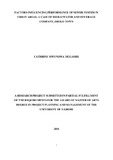| dc.description.abstract | The study was to investigate the factors that influence the performance of sewer systems in urban areas with a focus on Isiolo water and Sewerage Company in Isiolo town. This study examined factors influencing sewer system in urban areas. Based on that, the researcher came up with some findings and recommendations on sewer performance. These findings is of great benefit to the Isiolo water and Sewerage Company since it finds out the causes of its poor sewer performance in service delivery and thus review their sewer policies in order to improve their service delivery and performance. Some respondents were unwilling to provide the required information on time, leading to delay in concluding the study. But in order to overcome the problem the researcher explained the importance of the study and promised confidentiality of individuals. The study adopted descriptive research design employing ex- post facto technique. According to Kothari (2009), this design will help the researcher to report what has already happened in the ground or what is happening since the problem has been well designed. The study population included all the 15 management employees of Isiolo water and Sewerage Company and the sewer consumers in Isiolo town. The sewer consumer population included the commercial and domestic consumers. There are 578 sewer consumers who comprise of both commercial and domestic. The study used stratified sampling method, where each institution was treated as a stratum. Since the population is not large for the IWASCO management and commercial consumers, and there are well organized structures where the respondents can be found easily, the researcher conducted a census. For the domestic consumers who are landlords, the researcher used a simple random method where 10% of all the respondents was selected. A list of all the domestic consumers was drawn from the sewer service provider. The researcher assigned numbers and every 10th consumer was picked as a respondents hence a total of 50 respondents from domestic consumers was used. A total sample of 128 respondents was used for the study. Primary data was collected by use of structured questionnaires, designed to gather information regarding the issues addressed in the research. The SPSS tool was used by the researcher to analyze data. Descriptive statistic was used. Quantitative data was represented using tables while qualitative data was presented in narrative form. The study identified a number of key factors which were directly related to sewer performance. They included population, system infrastructure, physical environment and System technology. The discussion of the findings of the study is centred on the major research questions directing the study. The study therefore sought to establish the factors that influence performance of sewer system in urban areas; a case of Isiolo Water and Sewerage Company, Isiolo town and the following conclusions were drawn from the findings of the study. The management of IWASCO should endeavor to improve the sewer system by either building enough sewer manholes to accommodate the increasing population growth. The management should keep up the good spirit of embracing modern technology that will enhance sewer performance. The management of IWASCO should endeavor to maximize their staff capacity by training them and equipping them with technology skills for effective management of sewer performance. | en_US |

